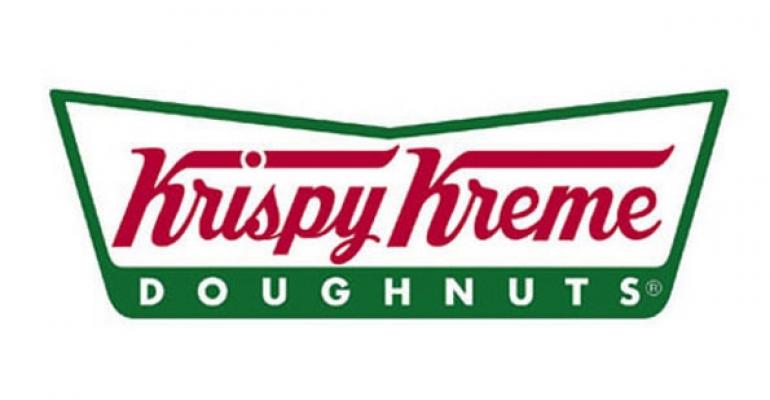Krispy Kreme Doughnuts Inc. predicts a a smaller prototype will reaccelerate corporate and franchised unit growth after a quarter in which the company grew revenue and domestic same-store sales more than 10 percent.
During the second quarter ended Aug. 4, Krispy Kreme opened units of its 2,400-square-foot prototype in North Carolina and Florida, bringing the number of those freestanding restaurants to five. Four to five more prototype locations are scheduled to open by the end of the year.
The new locations are on their way to achieving Krispy Kreme’s goal of generating a 20-percent cash-on-cash return on a lower sales volume of about $20,000 per week, which compares to the $35,000 per week a traditional freestanding Krispy Kreme averages, executives said.
RELATED
• Krispy Kreme celebrates 76th birthday via Facebook
• Krispy Kreme focuses on boosting beverage sales
• Franchising news at NRN.com
While Krispy Kreme officials were bullish on the new prototype’s ability to drive renewed corporate and franchise growth, the rate of openings would be prudent. The company is targeting expansion from 243 domestic units today to 400 by 2017.
“With the new model, you’ll see current franchisees who have not expanded in a long time being able to expand,” chief executive James Morgan said during the Winston-Salem, N.C.-based company’s earnings call. “So part of that 400 number is going to come from current franchisees, part of it’s going to come from company stores and our acceleration in those, and then the third part would be from new franchisees.”
The newest franchisee to enter the system is a large multiunit operator in Dallas, Sun Holdings, which bought three refranchised Krispy Kreme locations and agreed to open another 15 units in the market over the next five years.
Krispy Kreme’s pivot toward domestic growth represents another step in the turnaround for the company, which closed units precipitously in the middle of the last decade and endured lawsuits alleging that former management had “managed earnings” and inflated sales numbers reported to securities regulators.
Morgan has been chief executive since January 2008, when he took over for Daryl Brewster, who resigned after two years on the job. Brewster had replaced Scott Livengood, who resigned in 2005 at the height of Krispy Kreme’s legal and financial troubles.
“We cleaned up the balance sheet, paid off the debt and authorized the share repurchase,” Morgan said. “We’re now saying we are committed to this new model, and we think we are now poised, globally, to take this new and more efficient model forward. We’ve begun the new domestic franchise development. … We feel pretty doggone good about it.”
Morgan also indicated that Krispy Kreme was “engaged on more than one front with some potential franchisees, each of whom are multiunit operators that seem to be very attracted to the brand.”
Resources for smaller franchisees
Some of the larger multiunit franchisees showing renewed interest in Krispy Kreme might have an easier time securing growth capital, while smaller regional operators might struggle more for financing, Morgan said. But the company would explore ways it could deploy some of its more than $60 million in cash on hand to enable franchise growth, including an equipment financing package for franchisees.
“The state of financing for franchisee development kind of depends on who you are in the franchise world,” chief financial officer Doug Muir said. “But my sense is that the money is out there, and particularly when I think we’re at the point now, we can generate what appear to be some pretty strong economic returns on the investments.”
Krispy Kreme would also prepare to increase company-owned unit growth as well in the near term, Morgan added, though securing real estate is a major challenge that the company first had to address through its staffing. Two new executives have joined the company in the past three months to help with real estate site selection, he said.
Opening more corporate locations, very likely in new markets, would be a prudent use of Krispy Kreme’s free cash flow, Muir said. “Our first choice, given the ROIs we think we can get, would be to pick up the pace of company-store investment,” he said, “and that could mean, and probably does mean, more geography than we have discussed in detail so far.”
The company also expects all of the nearly 100 domestic company-owned units to have new point-of-sale hardware and software installed by the end of the year. Franchisees controlling about 60 of the 150 domestic franchised units indicated to Krispy Kreme that they want to begin implementing the new system as soon as possible, Muir said.
“It was well-tested on the front end and so far has been remarkably glitch-free,” he said. “Part of the software that could be business-changing — for example, pay-by-phone or loyalty programs — are only now being white-boarded and wouldn’t be implemented into the software until 2014 at the earliest. … But I can tell you, the marketing people are really excited about the potential of that.”
Krispy Kreme operates 93 company-owned units and franchises another 150 locations in the United States, and it franchises another 546 restaurants in 21 international markets.
Contact Mark Brandau at [email protected].
Follow him on Twitter: @Mark_from_NRN




